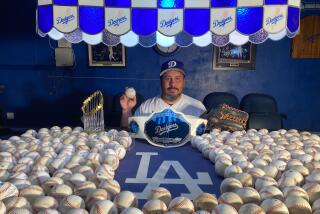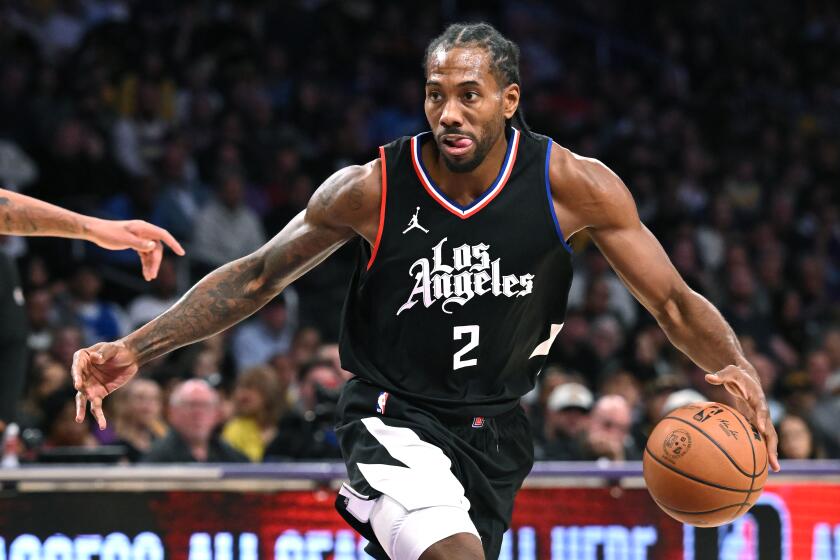U.S. Seems to Be the Land of Opportunity for Foreign Athletes : Valenzuela and Navratilova Are Two Who Have Cashed In
He was a moon-faced, sixth-grade dropout from the tiny Mexican village of Etchohuaquila who moved north across the border to scrub out a living, not in the fruitlands of California, but in a smaller field known as a diamond.
He threw a baseball--fast enough to make it look like a grape to major league hitters -- and within two years he was responsible for “Fernandomania.” While still barely able to speak English, Fernando Valenzuela was lunching with President Reagan at the White House as the million-dollar ace of the Los Angeles Dodgers pitching staff.
Now 24, he drives a sleek Corvette with personalized “FV34” plates, he has a three-bedroom condominium with a panoramic view of Los Angeles, and he has built his parents a mansion back in Etchohuaquila.
A pudgy teen-age tennis player from Czechoslovakia stood under a tent at the West Side Tennis Club in Forest Hills, N.Y., and announced, in faltering English, that she didn’t want to return to her Communist homeland. She wanted to be an American.
Some six years and several million dollars later, on July 21, l981, she was granted U. S. citizenship.
At age 27, Martina Navratilova has become one of the most affluent professional athletes, male or female, in any sport, and one of the most dominant players ever in women’s tennis.
The “Americanization” of Martina has included jeans, jazz, Gucci purses, fast cars and homes in Texas and New York. She is a one-woman conglomerate, surrounded by a staff of specialists who not only handle her profitable commercial enterprises, but monitor her training, diet and frame of mind.
Valenzuela and Navratilova represent the epitome of the newest breed of immigrant, lured to American shores by the promise of a better and richer life.
Unlike the millions who passed through Ellis Island, many of those migrating today have found they can parlay athletic skills into instant riches.
America has become a ripe prospecting land not only because of its prestigious tournaments, but because it provides athletes with broad television exposure and unlimited opportunities for extra commerical income.
In baseball, Valenzuela is just one of the 111 foreign-born players listed on 1985 major league rosters. While most of them are from Latin America, long a baseball breeding ground, some have come from countries such as Germany, France and Canada.
Not all are millionaires like Valenzuela, who is still cultivating a merchandising image, but average baseball paychecks aren’t bad either. The average salary for some 500 players is $360,000.
Nearly half the imported major leaguers have established permanent homes in the United States. Among them: the Dominican Republic’s Cesar Cedeno of the Cincinnati Reds, Panama’s Ben Oglivie of the Milwaukee Brewers and Nicaragua’s Dennis Martinez of the Baltimore Orioles. The Reds’ Dave Concepcion and Mario Soto head home for the winter--Concepcion to Venezuela and Soto to the Dominican Republic.
The mother lodes of America’s gold mines, however, are found in the tennis and golf tours, both men and women, young and old.
The richest is the PGA Tour, which annually generates $30 million in prize money. It launched both Arnold Palmer and Jack Nicklaus on golf and business careers that net each $250 million to $400 million a year.
Gary Player, the South African with an affinity for black playing attire, was one of the first to recognize the limitless wealth tied to the divots and sand traps on U.S. courses.
The diminutive shotmaker from Johannesburg had a commuter airline ticket to cross the Atlantic, starting in 1957. During a 27-year span, he never missed a campaign, winning 21 tour victories and amassing career earnings of more than $1.8 million.
Although he spent half his life in the United States, Player never chose to settle here. He always returned to his wife, Vivienne, and their six children, on the sprawling family horse farm outside Johannesburg.
After Player, foreign golfers started coming over in small clusters: Australians Peter Thomson, Bruce Crampton, Bruce Devlin and David Graham, Canada’s Al Balding and George Knudson, New Zealand’s Bob Charles, South Africa’s Harold Henning and Argentina’s Roberto de Vicenzo.
All dug deeply into the loot. Crampton stayed long enough to win a million dollars, then returned Down Under. Graham pushed his earnings past the $1.4 million mark, won the U. S. Open and PGA and almost won the British Open this year before bowing to Scotland’s Sandy Lyle.
Graham has settled in Dallas, where he divides his time between golf and business interests. Devlin liked Houston and stayed.
Thomson, who played the U.S. tour in the 1950s and has won five British Opens, is now on the PGA Senior Tour, which has become a lucrative option for players 50 years and older. Through July he led the year’s money list with more than $220,000 in winnings, and soared well over the half-million mark for career earnings.
The Senior Tour, which has allowed Don January to go over $1 million this year, is attracting other oldsters such as de Vicenzo, Crampton, Kel Nagle of Australia and Christie O’Connor of Ireland.
Bernhard Langer, the West German who won this year’s Masters, has jumped into the Top Ten of the regular PGA Tour with more than $250,000 in earnings.
Spain’s attractive Seve Ballesteros, twice a Masters champion, would have passed the $1 million plateau had he not chosen to divide his time between the American and European tours.
More than a dozen foreigners draw hefty incomes on the circuit, including players such as Greg Norman of Australia, Isao Aoki of Japan, Denis Watson of South Africa, Tze-Chung Chen of Taiwan, Nick Faldo and Peter Oosterhuis from Britain and Sandy Lyle, the Scot who won the 1985 British Open champion.
Outsiders have made less impact on the women’s golf tour although Australian Jan Stephenson has surged past the $1 million mark in earnings, captured the U. S. Women’s Open (1983) and become one of the sport’s most glamorous players.
Like Navratilova, she, too, has become “Americanized.” Now wed to Houston oilman Eddie Vossler, she is involved in numerous U.S. commercial ventures, including movies and aerobics.
Other foreign-born players on the women’s tour include Ayako Okamoto and Atsuko Hikage of Japan, Jane Crafter and Penny Pulz of Australia, Lisa Young, Barb Bunkowsky and Dawn Coe of Canada, Anne-Marie Palli of France, Silvia Bertolaccini of Argentina and Charlotte Montgomery of Sweden.
Sally Little, winner of 14 tournaments and close to $1 million, was born in Cape Town, South Africa, but now is a U.S. citizen.
But it is Navratilova, winner of a sixth Wimbledon crown this year, who dominates all the sweepstakes in women’s sports. She ranked fourth in sport’s top money winners for 1984, just behind boxers Marvelous Marvin Hagler, Ray “Boom Boom” Mancini and Thomas “Hit Man” Hearns, all profiting from big gates.
Her earnings for the year was placed at $2,173,556, which included a $1 million bonus for capturing four consecutive Grand Slam events. She outdid other sports personalities such as Mike Schmidt, Moses Malone, Larry Bird and David Winfield in a rollcall of sports’s millionaires by Sport Magazine.
Among her competitors, Czechoslovakia’s Hana Mandlikova and Helena Sukova, West Germany’s Claudia Kohde-Kilsch, Bulgaria’s Manuela Maleeva and Canadian Carling Bassett are in the $100,000 to $300,000 bracket. They go home during season breaks.
In men’s tennis, Ivan Lendl, the hard-hitting Czechoslovak, averages more than $1 million a year in tournament earnings alone. He keeps all but 20 percent (which goes to the Czech tennis association), and that tidy remainder allows him to live the life of an aristocrat in Greenwich, Conn.
France’s Yannick Noah and South African Kevin Curran, have settled in this country -- Noah in New York, Curren in Austin, Texas.
Several foreign-born “grand masters” of tennis decided to make their homes in America after their careers on the tour ended, including Australians Rod Laver, Fred Stolle, Mal Anderson and John Newcombe.
Their former Davis Cup captain, Harry Hopman, left Australia years ago to set up shop first at Port Washington (N. Y.) Academy and then Largo, Fla., to become the world’s most renowned and successful teacher.
Only recently has the National Basketball Association become a source of wealth for foreign players, drawn here mostly by the lure of a college scholarship. The most prominent is Nigerian Akeem Olajuwon of Houston, whose contract is said to be roughly $1 million a year.
Other highly paid recruits from other lands in the NBA include West Germany’s Detlef Schremp (University of Washington) and Uwe Blab (Indiana) and Canadian Bill Wennington (St. John’s), all with Dallas.
The 7-foot-6 3/4 Manute Bol from the Sudan, who played at the University of Bridgeport (Conn.), was paid $25,000 to play with the Rhode Island Gulls of the U. S. Basketball League. Bol was drafted by the Washington Bullets, played on their summer league team, but has not signed an NBA contract.
While football is principally an American institution, the character of the game was changed when a Hungarian refugee family named Gogolak fled the Soviets in 1952 and settled in New York.
Two Gogolak children, Pete and Charlie, proved they could kick field goals farther and more accurately by using a soccer-style boot and by kicking with the inside of the foot rather than the toe. In the mid-1960s, Pete wound up with the New York Giants, Charlie with the Washington Redskins. Charlie insured his right foot for $1 million.
The revolutionary method caught on. It wasn’t long before virtually every team in the National Football League had acquired a soccer-style kicker.
Of the 34 foreign-born players listed on NFL training camp rosters, nine are soccer-style kickers. Most prominent are Jan Stenerud, a Norwegian with the Minnesota Vikings; Ray Wersching, an Austrian who plays for the San Francisco 49ers.
Soccer, the world’s biggest “foot sport,” never quite caught on in the States. In 1975, Warner Communications lured the world’s greatest soccer player, Brazil’s Pele, with a three-year contract for $7 million to play for the Cosmos of the North American Soccer League.
The purpose was to try to make soccer as popular in America as it was throughout the rest of the world. Excitement ran high for a while. Then the flame flickered and died.
The great players of Europe and South America went home, carrying with them bags of U.S. dollars.
More to Read
Get our high school sports newsletter
Prep Rally is devoted to the SoCal high school sports experience, bringing you scores, stories and a behind-the-scenes look at what makes prep sports so popular.
You may occasionally receive promotional content from the Los Angeles Times.






